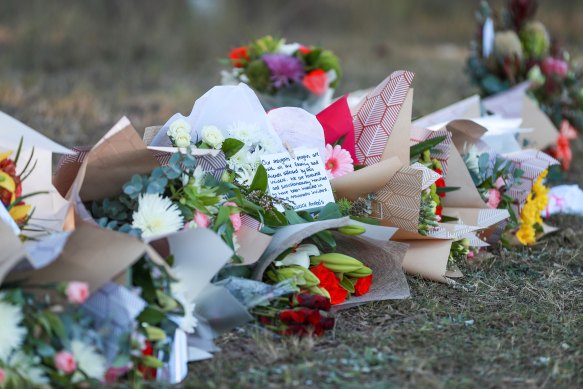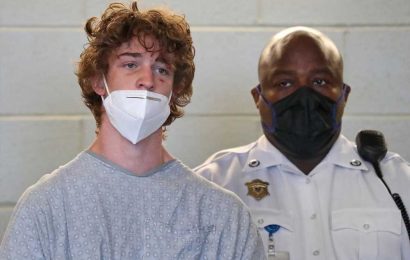Save articles for later
Add articles to your saved list and come back to them any time.
At the end of a difficult week, many still feel disbelief over the Hunter Valley bus crash. We are undoubtedly united in sadness and horror that the happy occasion of a young couple’s wedding could end in such a way. Ten people killed and others with physical and mental scars.
Floral tributes lie next to the road where a horror bus crash claimed 10 lives last Sunday night.Credit: Roni Bintang/Getty Images
My husband and I celebrated our 10-year wedding anniversary a few months ago. We were lucky to host our wedding at a winery on the Bellarine Peninsula. Like Mitchell Gaffney and Maddy Edsell, we organised buses to take our guests back to their accommodation at the end of the night. On Monday my mind couldn’t help but wander there … I shudder at the thought.
Those of us who weren’t there on Sunday night cannot really fathom what these newlyweds, their guests and their families are going through this week, and what they’ll face in the weeks and years to come. As Prime Minister Anthony Albanese said in the immediate aftermath: “The mental scars of this will not go away. They are there forever, and we need to make sure that when the spotlight leaves, the care doesn’t, for people who have witnessed this, and for people who have experienced this tragedy first hand.”
There has been enormous reader interest in this tragedy throughout the week. Perhaps many of you are trying to make sense of it all. There was also some negative feedback: a handful of letters and some social media posts critical of our coverage, in particular our decision to name the victims and publish the couple’s wedding photos.
With such events, there is always discussion in the newsroom about what is appropriate: whether to publish victims’ photos, how – or even whether – to approach victims’ families and friends for comment, what details to make public, and how to approach the wording around the condition of victims and their injuries. All these are considered, and at times debated. For 48 hours, we reported that the 10 victims named were “unaccounted for”, recognising that police were still trying to identify those who had died.
Before we published our story on Tuesday night about Darcy Bulman, the 30-year-old Melbourne woman among those killed, I paused and read it over several times. The weight of knowledge that this would be how thousands of people, strangers, would come to know Darcy wasn’t lost on me. How would she be remembered? How would she want to be remembered? Are her partner, friends and family getting the support they need?
I can think of several occasions in the five months that I’ve been in the role of deputy editor when I’ve witnessed newsroom staff visibly moved by unfolding events. News in April that a teen and his school friend had been charged with the murder of his mother (“How does this happen?” we asked), and last month’s Exford bus crash that saw several children left with life-changing injuries, are just a couple of instances. And then on Monday, the Hunter Valley horror.
During a morning news conference mid-week, as we discussed our list of stories for the day, we asked, “Where’s the happy news?” It’s something our readers may have wondered too, hopeful for a reprieve. A colleague replied, “I can’t stop thinking about the bus crash.”
The devastating ripple effect of a tragedy such as this spreads far beyond the victims and their immediate friends and family – to communities around the country, to first responders, police investigators and hospital staff – and, yes, to journalists covering the story. There is now an increased and welcome focus on how we look after reporters and photographers who work on such stories, who often attend the scene and speak to those directly affected by events.
This week I was reminded of the first time I was asked to do a dreaded “death doorknock” – contacting a family who had lost a loved one. I was a 21-year-old reporter. I’m grateful the memory has stayed with me for the right reason … how a busy news editor patiently sat with me and prepared me for a difficult conversation with people who were in the midst of what was likely to be the worst days of their life.
A colleague once asked why I was willing to approach victims’ families at such times. She had refused. On reflection, it was because I was empowered by that news editor to approach the situation in the most sensitive way we knew how. To give the family member an opportunity to speak about their loved one and share their memories, but leave if turned away, even if that meant not “getting the story”. Senior reporters also came by my desk later that day all those years ago to check-in on me.
This week our colleagues in Sydney, who did much of the reporting on this sad and confronting event in NSW, were reminded about the support available to them, in the form of counselling services as well as from their managers and the wider newsroom. And, of course, from their colleagues here in Melbourne too. It’s not something these reporters, or anyone touched by the terrible events of last Sunday night, will quickly forget.
The editor sends an exclusive newsletter to subscribers each week. Sign up to receive our Note from the Editor.
Most Viewed in National
From our partners
Source: Read Full Article








